Proposing a Pedagogical Framework for Integrating Urban Agriculture as a Tool to Achieve Social Sustainability within the Interior Design Studio
Abstract
:1. Introduction
2. Literature Review: Future Urban Growth and Urban Agriculture
2.1. Integrating Social Sustainability in the Interior Design Studio
2.2. Residential Urban Agriculture
3. Methodology: Context-Based and Culture-Based Design Approach
- This research is based on the after-mentioned three research questions. Research question one: How can the concept of residential urban agriculture influence the interior design studio pedagogy?
- Research question two: How are the concepts of social sustainability and residential urban agriculture embedded with the interior design studio learning outcomes?
- Research question three: How can Cypriots arrange and maintain their edible gardens and green decorative elements within their residential buildings in the Kyrenia district, and how can such local practices be integrated within the interior design studio?
3.1. Data Collection
3.2. Case Study: Cypriot Houses
4. Results: Interior Design Studio Pedagogy
4.1. Limitations of the Proposed Framework
4.2. Novelty of the Proposed Framework
5. Discussion
6. Conclusions
- (1)
- The concept of residential urban agriculture is based on the notion that future interior and exterior spaces (such as window sills, beneath skylights; south-, east-, and west-facing rooms; balconies; south-, east-, and west-facing elevations; and rooftops) are ideal grounds for cultivating food. Innovative methods for cultivating food, such as hydroponic systems equipped with grow lights, can be utilized in interior spaces, balconies, and rooftops. Greenhouses can be added to the building’s elevations, windows, and rooftops, and food can be cultivated in them. The studio lecturers believe that by practicing residential urban agriculture and cultivating food in future cities, the future burden on the agriculture sector can be reduced. Furthermore, by practicing urban agriculture, social, economic, and environmental benefits can be gained.
- (2)
- By following the context-based and culture-based design approach, young interior architects record how Cypriots arrange and maintain their edible gardens and green decorative elements within their residential buildings in the Kyrenia district. This design approach encourages young interior architects to value, study, and reflect mentioned local practices within their interior design projects.
- (3)
- The proposed studio pedagogy also considers the social aspect of sustainability. The incorporation of social aspects of sustainability within the studio pedagogy can be considered a response to contemporary as well as future social and environmental issues. The studio pedagogy is intertwined with the threefold social sustainability that comprises development, bridge, and maintenance sustainability. The principal goals of the mentioned threefold schema are as follows. (1) Development sustainability focuses on satisfying the basic needs of individuals in a society. Practicing residential urban agriculture can enhance access to a nutritious diet and, in this way, one of the basic needs of individuals in a society can be satisfied. The proposed studio pedagogy attempts to be responsive to real social, environmental, and economic issues, such as satisfying people’s basic needs in a society. (2) Bridge sustainability, the proposed studio pedagogy, focuses on a non-transformative approach, which means that young interior architects are encouraged to integrate innovative food production methods within their design projects. The studio lecturers believe that local Cypriots can utilize innovative food production methods in their residential buildings considering their local practices. (3) Maintenance sustainability focuses on maintaining traditions and practices that local people in a society are eager to preserve. Fieldwork results show that local Cypriots are generally interested in cultivating food and decorating their residential buildings with green elements. The proposed studio pedagogy recognizes and values local practices and encourages young interior architects to integrate them into their design projects.
6.1. Academic/Practical Implications
6.2. Future Research
Author Contributions
Funding
Conflicts of Interest
References
- Vallance, S.; Perkins, H.C.; Dixon, J.E. What is social sustainability? A clarification of concepts. Geoforum 2011, 42, 342–348. [Google Scholar] [CrossRef]
- Altomonte, S.; Rutherford, P.; Wilson, R. Mapping the Way Forward: Education for Sustainability in Architecture and Urban Design. Corp. Soc. Responsib. Environ. Manag. 2014, 21, 143–154. [Google Scholar] [CrossRef]
- Grover, R.; Emmitt, S.; Copping, A. Critical learning for sustainable architecture: Opportunities for design studio pedagogy. Sustain. Cities Soc. 2020, 53, 101876. [Google Scholar] [CrossRef]
- Altomonte, S. Handle with care. The challenges of sustainability and the agenda of architectural education. In Teaching a New Environmental Culture: The Environment as a Question of Architectural Education; Voyatzaki, M., Ed.; European Association for Architectural Education: Nicosia, Cyprus, 2011; pp. 29–43. [Google Scholar]
- Cotgrave, A.; Alkhaddar, R. Greening the Curricula within Construction Programmes. J. Educ. Built Environ. 2006, 1, 3–29. [Google Scholar] [CrossRef]
- Altomonte, S. Environmental Education for Sustainable Architecture. Rev. Eur. Stud. 2009, 1, 12–21. [Google Scholar] [CrossRef]
- Ceylan, S.; Soygeniş, M.D. A design studio experience: Impacts of social sustainability. Archnet-IJAR Int. J. Arch. Res. 2019, 13, 368–385. [Google Scholar] [CrossRef]
- UN. World Urbanization Prospects: The 2009 Revision, Highlights; United Nations Population Division: New York, NY, USA, 2010. [Google Scholar]
- UN. World Urbanization Prospects: The 2014 Revision, Highlights; United Nations Population Division: New York, NY, USA, 2014. [Google Scholar]
- UN. World Population Prospects: The 2012 Revision; United Nations: New York, NY, USA, 2013; Available online: https://population.un.org/wpp/Publications/Files/WPP2012_HIGHLIGHTS.pdf (accessed on 15 January 2022).
- UN. World Population Prospects: Key Findings and Advance Tables; United Nations: New York, NY, USA, 2015; Available online: https://population.un.org/wpp/Publications/Files/Key_Findings_WPP_2015.pdf (accessed on 15 January 2022).
- UN. World Population Prospects 2019: Highlights; United Nations Population Division: New York, NY, USA, 2019; Available online: https://population.un.org/wpp/Publications/Files/WPP2019_Highlights.pdf (accessed on 15 January 2022).
- Gerland, P.; Raftery, A.E.; Ševčíková, H.; Li, N.; Gu, D.; Spoorenberg, T.; Alkema, L.; Fosdick, B.K.; Chunn, J.; Lalic, N.; et al. World population stabilization unlikely this century. Science 2014, 346, 234–237. [Google Scholar] [CrossRef] [Green Version]
- Black, R.; Kniveton, D.; Skeldon, R.; Coppard, D.; Murata, A.; Schmidt-Verkerk, K. Demographics and Climate Change: Future Trends and Their Policy Implications for Migration; Development Research Centre on Migration, Globalisation and Poverty, University of Sussex: Brighton, UK, 2008; Available online: https://gsdrc.org/document-library/demographics-and-climate-change-future-trends-and-their-policy-implications-for-migration/ (accessed on 15 February 2022).
- Cohen, B. Urbanization in developing countries: Current trends, future projections, and key challenges for sustainability. Technol. Soc. 2006, 28, 63–80. [Google Scholar] [CrossRef]
- UN. World Urbanization Prospects: The 2018 Revision, Key Facts; United Nations Population Division: New York, NY, USA, 2018. [Google Scholar]
- UN. World Population to 2300; Department of Economic and Social Affairs, Population Division: New York, NY, USA, 2004. [Google Scholar]
- Crush, J.; Hovorka, A.; Tevera, D. Food security in Southern African cities. Prog. Dev. Stud. 2011, 11, 285–305. [Google Scholar] [CrossRef] [Green Version]
- FAO. Arable Land (Hectares per Person); The World Bank: Washington, DC, USA, 2021; Available online: https://data.worldbank.org/indicator/AG.LND.ARBL.HA.PC?end¼2013&start¼1961&view¼chart (accessed on 15 February 2022).
- Benke, K.; Tomkins, B. Future food-production systems: Vertical farming and controlled-environment agriculture. Sustain. Sci. Pract. Policy 2017, 13, 13–26. [Google Scholar] [CrossRef] [Green Version]
- FAO. Agricultural Land (% of Land Area)—Cyprus; The World Bank: Washington, DC, USA, 2021; Available online: https://data.worldbank.org/indicator/AG.LND.AGRI.ZS?locations=CY (accessed on 15 February 2022).
- Fedoroff, N.V. Food in a future of 10 billion. Agric. Food Secur. 2015, 4, 11. [Google Scholar] [CrossRef] [Green Version]
- Astee, L.Y.; Kishnani, N.T. Building Integrated Agriculture: Utilising Rooftops for Sustainable Food Crop Cultivation in Singapore. J. Green Build. 2010, 5, 105–113. [Google Scholar] [CrossRef]
- Eigenbrod, C.; Gruda, N. Urban vegetable for food security in cities: A review. Agric. Sustain. Dev. 2015, 35, 483–498. [Google Scholar] [CrossRef] [Green Version]
- Kozai, T.; Niu, G. Role of the plant factory with artificial lighting (PFAL) in urban areas. In Plant Factory: An Indoor Vertical Farming System for Efficient Quality Food Production; Kozai, T., Niu, G., Takagaki, M., Eds.; Elsevier: London, UK, 2016; pp. 7–33. [Google Scholar]
- Cohen, J.E. Human Population: The Next Half Century. Science 2003, 302, 1172–1175. [Google Scholar] [CrossRef]
- Wold Bank. Arable Land (Hectares per Person). Data. Available online: https://data.worldbank.org/indicator/AG.LND.ARBL.HA.PC?end=2018&start=1961&view=chart (accessed on 2 January 2022).
- World Bank. Arable Land (Hectares per Person)—Cyprus. Data. Available online: https://data.worldbank.org/indicator/AG.LND.ARBL.HA.PC?locations=CY (accessed on 2 January 2022).
- Ray, D.K.; Mueller, N.D.; West, P.C.; Foley, J.A. Yield trends are insufficient to double global crop production by 2050. PLoS ONE 2013, 8, e66428. [Google Scholar] [CrossRef] [Green Version]
- Tilman, D.; Balzer, C.; Hill, J.; Befort, B.L. Global food demand and the sustainable intensification of agriculture. Proc. Natl. Acad. Sci. USA 2011, 108, 20260–20264. [Google Scholar] [CrossRef] [Green Version]
- FAO. How to Feed the World in 2050. 2009. Available online: http://www.fao.org/fileadmin/templates/wsfs/docs/expert_paper/How_to_Feed_the_World_in_2050.pdf (accessed on 27 January 2022).
- OECD; FAO. OECD-FAO Agricultural Outlook 2012–2021; OECD Publishing; FAO: New York, NY, USA, 2012; Available online: https://reliefweb.int/sites/reliefweb.int/files/resources/OECD_FAO_Ag-outlook2012_ENG.pdf (accessed on 27 January 2022).
- FAO. Feeding the World in 2050; FAO: Rome, Italy, 2009; Available online: https://www.fao.org/fileadmin/templates/wsfs/Summit/WSFS_Issues_papers/WSFS_feeding_E.pdf (accessed on 27 January 2022).
- Morgan, K. Feeding the City: The Challenge of Urban Food Planning. Int. Plan. Stud. 2009, 14, 341–348. [Google Scholar] [CrossRef]
- Specht, K.; Siebert, R.; Hartmann, I.; Freisinger, U.B.; Sawicka, M.; Werner, A.; Thomaier, S.; Henckel, D.; Walk, H.; Dierich, A. Urban agriculture of the future: An overview of sustainability aspects of food production in and on buildings. Agric. Hum. Values 2013, 31, 33–51. [Google Scholar] [CrossRef]
- Bohn, K.; Viljoen, A. The edible city: Envisioning the continuous productive urban landscape (CPUL). Field J. 2011, 4, 149–161. [Google Scholar]
- Bryld, E. Potentials, problems, and policy implications for urban agriculture in developing countries. Agric. Hum. Values 2003, 20, 79–86. [Google Scholar] [CrossRef]
- Horst, M.; McClintock, N.; Hoey, L. The Intersection of Planning, Urban Agriculture, and Food Justice: A Review of the Literature. J. Am. Plan. Assoc. 2017, 83, 277–295. [Google Scholar] [CrossRef] [Green Version]
- Ackerman, K.; Conard, M.; Culligan, P.; Plunz, R.; Sutto, M.P.; Whittinghill, L. Sustainable food systems for future cities: The potential of urban agriculture. Econ. Soc. Rev. 2014, 45, 189–206. [Google Scholar]
- Zezza, A.; Tasciotti, L. Urban agriculture, poverty, and food security: Empirical evidence from a sample of developing countries. Food Policy 2010, 35, 265–273. [Google Scholar] [CrossRef]
- Enete, A.A.; Achike, A.I. Urban Agriculture and Urban Food Insecurity/Poverty in Nigeria. Outlook Agric. 2008, 37, 131–134. [Google Scholar] [CrossRef]
- Widome, R.; Neumark-Sztainer, D.; Hannan, P.J.; Haines, J.; Story, M. Eating When There is Not Enough to Eat: Eating Behaviors and Perceptions of Food Among Food-Insecure Youths. Am. J. Public Health 2009, 99, 822–828. [Google Scholar] [CrossRef]
- Mok, H.-F.; Williamson, V.G.; Grove, J.R.; Burry, K.; Barker, S.F.; Hamilton, A.J. Strawberry fields forever? Urban agriculture in developed countries: A review. Agron. Sustain. Dev. 2014, 34, 21–43. [Google Scholar] [CrossRef] [Green Version]
- FAO. Growing Greener Cities in Latin America and the Caribbean; Food and Agriculture Organization of the United Nations: Rome, Italy, 2014; Available online: http://www.fao.org/ag/agp/greenercities/en/ggclac/downloads.html (accessed on 7 March 2022).
- Stewart, R.; Korth, M.; Langer, L.; Rafferty, S.; Da Silva, N.R.; Rooyen, C.V. What are the impacts of urban agriculture programs on food security in low and middle-income countries? Environ. Evid. 2013, 2, 7. [Google Scholar] [CrossRef] [Green Version]
- Azunre, G.A.; Amponsah, O.; Peprah, C.; Takyi, S.A.; Braimah, I. A review of the role of urban agriculture in the sustainable city discourse. Cities 2019, 93, 104–119. [Google Scholar] [CrossRef]
- Obach, B.K.; Tobin, K. Civic agriculture and community engagement. Agric. Hum. Values 2014, 31, 307–322. [Google Scholar] [CrossRef]
- Pole, A.; Gray, M. Farming alone? What’s up with the “C” in community supported agriculture. Agric. Hum. Values 2013, 30, 85–100. [Google Scholar] [CrossRef]
- Hamilton, A.J.; Burry, K.; Mok, H.-F.; Barker, F.; Grove, J.R.; Williamson, V.G. Give peas a chance? Urban agriculture in developing countries. A review. Agron. Sustain. Dev. 2014, 34, 45–73. [Google Scholar] [CrossRef] [Green Version]
- Walker, S. Urban agriculture and the sustainability fix in Vancouver and Detroit. Urban Geogr. 2016, 37, 163–182. [Google Scholar] [CrossRef]
- Nelkin, J.; Caplow, T. Sustainable controlled environment agriculture for urban areas. Acta Hortic. 2008, 801, 449–456. [Google Scholar] [CrossRef]
- Mensah, J. Sustainable development: Meaning, history, principles, pillars, and implications for human action: Literature review. Cogent Soc. Sci. 2019, 5, 1653531. [Google Scholar] [CrossRef]
- Scopelliti, M.; Molinario, E.; Bonaiuto, F.; Bonnes, M.; Cicero, L.; De Dominicis, S.; Fornara, F.; Admiraal, J.; Beringer, A.; Dedeurwaerdere, T.; et al. What makes you a ‘hero’ for nature? Socio-psychological profiling of leaders committed to nature and biodiversity protection across seven EU countries. J. Environ. Plan. Manag. 2018, 61, 970–993. [Google Scholar] [CrossRef] [Green Version]
- Shepherd, E.; Milner-Gulland, E.; Knight, A.; Ling, M.A.; Darrah, S.; Soesbergen, A.; Burgess, N.D. Status and Trends in Global Ecosystem Services and Natural Capital: Assessing Progress Toward Aichi Biodiversity Target 14. Conserv. Lett. 2016, 9, 429–437. [Google Scholar] [CrossRef]
- Du Pisani, J.A. Sustainable development—Historical roots of the concept. Environ. Sci. 2006, 3, 83–96. [Google Scholar] [CrossRef]
- Reyes, G.E. Four Main Theories of Development: Modernization, Dependency, Word-System, and Globalization. Nómadas. Rev. Crítica de Cienc. Soc. Y Jurídicas 2001, 4, 109–124. University of Pittsburgh, USA. Available online: https://pdfs.semanticscholar.org/e36b/27f7b884e8b5a94d15c1382b99c8416af2ff.pdf (accessed on 7 March 2022).
- Basiago, A.D. Economic, social, and environmental sustainability in development theory and urban planning practice. Environmentalist 1998, 19, 145–161. [Google Scholar] [CrossRef]
- Klarin, T. The Concept of Sustainable Development: From its Beginning to the Contemporary Issues. Zagreb Int. Rev. Econ. Bus. 2018, 21, 67–94. [Google Scholar] [CrossRef] [Green Version]
- UN. Report of the United Nations Conference on the Human Environment; United Nations: New York, NY, USA, 1973. [Google Scholar]
- WCED. Report of the World Commission on Environment and Development: Our Common Future; United Nations: New York, NY, USA, 1987; Available online: https://sustainabledevelopment.un.org/content/documents/5987our-common-future.pdf (accessed on 3 March 2022).
- Schaefer, A.; Crane, A. Addressing Sustainability and Consumption. J. Macromarketing 2005, 25, 76–92. [Google Scholar] [CrossRef] [Green Version]
- Elkington, J. Towards the Sustainable Corporation: Win-Win-Win Business Strategies for Sustainable Development. Calif. Manag. Rev. 1994, 36, 90–100. [Google Scholar] [CrossRef]
- Shirazi, M.R.; Keivani, R. Critical reflections on the theory and practice of social sustainability in the built environment—A meta-analysis. Local Environ. 2017, 22, 1526–1545. [Google Scholar] [CrossRef] [Green Version]
- Littig, B.; Griessler, E. Social sustainability: A catchword between political pragmatism and social theory. Int. J. Sustain. Dev. 2005, 8, 65. [Google Scholar] [CrossRef] [Green Version]
- Peterson, N. Introduction to the special issue on social sustainability: Integration, context, and governance. Sustain. Sci. Pract. Policy 2016, 12, 3–7. [Google Scholar] [CrossRef]
- Stender, M.; Walter, A. The role of social sustainability in building assessment. Build. Res. Inf. 2018, 47, 598–610. [Google Scholar] [CrossRef]
- Grum, B.; Grum, D.K. Concepts of social sustainability based on social infrastructure and quality of life. Facilities 2020, 38, 783–800. [Google Scholar] [CrossRef]
- Dillard, J.; Dujon, V.; King, M.C. Introduction. In Understanding the Social Dimension of Sustainability; Dillard, J., Dujon, V., King, M.C., Eds.; Routledge: London, UK, 2009; pp. 1–12. [Google Scholar]
- Ali, A.; Faruquie, D.S. A quasi-systematic review on effectiveness of social and cultural sustainability practices in built environment. Int. J. Psychol. Behav. Sci. 2015, 9, 4298–4305. [Google Scholar] [CrossRef]
- Opoku, A. The role of culture in a sustainable built environment. In Sustainable Operations Management: Advances in Strategy and Methodology; Chiarini, A., Ed.; Springer: London, UK, 2015; pp. 37–52. [Google Scholar]
- Smith, D.; Beeck, S.; Lommerse, M.; Metcalfe, P. An Introduction to Social Sustainability and Interior Architecture. In Perspectives on Social Sustainability and Interior Architecture: Life from the Inside; Smith, D., Lommerse, M., Metcalfe, P., Eds.; Springer: London, UK, 2014; pp. 1–11. [Google Scholar]
- Bhatti, M.; Dixon, A. Special focus: Housing, environment and sustainability. Hous. Stud. 2003, 18, 501–504. [Google Scholar] [CrossRef]
- McBride, L. Exploring Common Ground Community Food Systems and Social Sustainability. In Understanding the Social Dimension of Sustainability; Dillard, J., Dujon, V., King, M.C., Eds.; Routledge: London, UK, 2009; pp. 233–247. [Google Scholar]
- Conway, T.M.; Brannen, K. Who is tending their garden? Edible gardens as a residential landscaping choice. Cities Environ. 2014, 7, 10. Available online: https://digitalcommons.lmu.edu/cate/vol7/iss2/10 (accessed on 20 March 2022).
- Bhatti, M.; Church, A. Cultivating Natures: Homes and Gardens in Late Modernity. Sociology 2001, 35, 365–383. [Google Scholar] [CrossRef]
- Bhatti, M.; Church, A. Home, the culture of nature and meanings of gardens in late modernity. Hous. Stud. 2004, 19, 37–51. [Google Scholar] [CrossRef]
- Assefa, G.; Frostell, B. Social sustainability and social acceptance in technology assessment: A case study of energy technologies. Technol. Soc. 2007, 29, 63–78. [Google Scholar] [CrossRef]
- Rana, R.S.J.B.; Piracha, A.L. Cultural frameworks. In Urban Crisis: Culture and the Sustainability of Cities; Nadarajah, M., Yamamoto, A.T., Eds.; United Nations University Press: Tokyo, Japan, 2007; pp. 13–50. [Google Scholar]
- Cohen, N.; Reynolds, K.; Sanghvi, R. Five Borough Farm: Seeding the Future of Urban Agriculture in New York City. Design Trust for Public Space. 2012. Available online: https://www.researchgate.net/publication/281107661_Five_Borough_Farm_Seeding_the_Future_of_Urban_Agriculture_in_New_York_City (accessed on 20 March 2022).
- Mougeot, L.J.A. Urban Food Production: Evolution, Official Support and Significance. Cities Feeding People Series. 1994. Available online: https://idl-bnc-idrc.dspacedirect.org/bitstream/handle/10625/14949/103013.pdf?sequence=1 (accessed on 20 November 2021).
- Mougeot, L.J.A. Urban Agriculture: Definition, Presence, Potentials and Risks, and Policy Challenges. International Development Research Centre. 2000. Available online: https://idl-bnc-idrc.dspacedirect.org/bitstream/handle/10625/26429/117785.pdf?sequence=12 (accessed on 20 March 2022).
- Pearson, L.J.; Pearson, L.; Pearson, C.J. Sustainable urban agriculture: Stocktake and opportunities. Int. J. Agric. Sustain. 2010, 8, 7–19. [Google Scholar] [CrossRef]
- Thebo, A.L.; Drechsel, P.; Lambin, E.F. Global assessment of urban and peri-urban agriculture: Irrigated and rainfed croplands. Environ. Res. Lett. 2014, 9, 114002. [Google Scholar] [CrossRef]
- Veenhuizen, R.V. Cities farming for the future. In Cities Farming for the Future: Urban Agriculture for Green and Productive Cities; Veenhuizen, R.V., Ed.; RUAF Foundation: Ottawa, ON, Canada, 2006; pp. 1–17. [Google Scholar]
- De Zeeuw, H.; VAN Veenhuizen, R.; Dubbeling, M. The role of urban agriculture in building resilient cities in developing countries. J. Agric. Sci. 2011, 149, 153–163. [Google Scholar] [CrossRef]
- Orsini, F.; Kahane, R.; Nono-Womdim, R.; Gianquinto, G. Urban agriculture in the developing world: A review. Agron. Sustain. Dev. 2013, 33, 695–720. [Google Scholar] [CrossRef] [Green Version]
- FAO. The State of Food and Agriculture; Food and Agriculture Organization of the United Nations: Rome, Italy, 1996; Available online: https://www.fao.org/3/w1358e/w1358e00.htm (accessed on 20 March 2022).
- FAO. Urban and Pre-Urban Agriculture; United Nations: New York, NY, USA, 2002; Available online: https://www.fao.org/unfao/bodies/coag/coag15/x0076e.htm (accessed on 10 March 2022).
- Dubbeling, M.; Orsini, F.; Gianquinto, G. Introduction. In Rooftop Urban Agriculture; Orsini, F., Dubbeling, M., de Zeeuw, H., Gianquinto, G., Eds.; Springer: Berlin/Heidelberg, Germany, 2017; pp. 3–8. [Google Scholar]
- Allaway, Z. Indoor Edible Garden; Penguin Random House: New York, NY, USA, 2017. [Google Scholar]
- Baras, T. DIY Hydroponic Gardens: How to Design and Build an Inexpensive System for Growing Plants in Water; Quarto Publishing Group: Minneapolis, MN, USA, 2018. [Google Scholar]
- Rodriguez-Delfin, A.; Gruda, N.; Eigenbrod, C.; Orsini, F.; Gianquinto, G. Soil based and simplified hydroponics rooftop gardens. In Rooftop Urban Agriculture; Orsini, F., Dubbeling, M., de Zeeuw, H., Gianquinto, G., Eds.; Springer: Berlin/Heidelberg, Germany, 2017; pp. 61–81. [Google Scholar]
- Puri, V.; Caplow, T. How to grow food in the 100% renewable city: Building-integrated agriculture. In 100% Renewable: Energy Autonomy in Action; Droege, P., Ed.; Earthscan: London, UK, 2009; pp. 229–241. [Google Scholar]
- Resh, H.M. Hydroponic Food Production: A Definitive Guidebook for the Advanced Home Gardener and the Commercial Hydroponic Grower; CRC Press: Boca Raton, FL, USA, 2013. [Google Scholar]
- Proksch, G. Creating Urban Agricultural Systems: An Integrated Approach to Design; Routledge: London, UK, 2017. [Google Scholar]
- Gordon, C.A.; Benoit, R. How to Window Box: Small-Space Plants to Grow Indoors or Out; Penguin Random House LLC: New York, NY, USA, 2018. [Google Scholar]
- Espiritu, K. Field Guide to Urban Gardening: How to Grow Plants, No Matter Where You Live; Cool Springs Press: Beverly, MA, USA, 2019. [Google Scholar]
- Mitchell, A. The Edible Balcony: Growing Fresh Produce in Small Spaces; Rodale Books: New York, NY, USA, 2012. [Google Scholar]
- Coronado, S. Grow a Living Wall: Create Vertical Gardens with Purpose; Cool Springs Press: Beverly, MA, USA, 2015. [Google Scholar]
- Andrychowicz, A. Vertical Vegetables: Simple Projects That Deliver More Yield in Less Space; Cool Springs Press: Beverly, MA, USA, 2018. [Google Scholar]
- Sabeh, N. Rooftop plant production systems in urban areas. In Plant Factory: An Indoor Vertical Farming System for Efficient Quality Food Production; Kozai, T., Niu, G., Takagaki, M., Eds.; Elsevier: London, UK, 2016; pp. 105–111. [Google Scholar]
- Montero, J.I.; Baeza, E.; Muñoz, P.; Sanyé-Mengual, E.; Stanghellini, C. Technology for Rooftop Greenhouses. In Rooftop Urban Agriculture; Orsini, F., Dubbeling, M., de Zeeuw, H., Gianquinto, G., Eds.; Springer: Berlin/Heidelberg, Germany, 2017; pp. 83–103. [Google Scholar]
- Ross, D.S. Planning a Home Greenhouse; Fact Sheet; University of Maryland at College Park: College Park, MD, USA, 2009; Available online: http://webinfotech.tzo.com/Gardening101/How%20to%20PDF’s/Greenhouses.PlanningAHomeGreenhouse.pdf (accessed on 10 March 2022).
- Baird, C. The Complete Guide to Building Your Own Greenhouse; Atlantic Publishing Group: Ocala, FL, USA, 2011. [Google Scholar]
- Salama, A. A theory for integrating knowledge in architectural design education. Int. J. Archit. Res. 2008, 2, 100–128. Available online: https://archnet.org/publications/5105 (accessed on 10 March 2022).
- Ryan, G. Introduction to positivism, interpretivism and critical theory. Nurse Res. 2018, 25, 14–20. [Google Scholar] [CrossRef] [PubMed]
- Krauss, U.P.S.E. Research Paradigms and Meaning Making: A Primer. Qual. Rep. 2005, 10, 758–770. [Google Scholar] [CrossRef]
- Draper, J. Ethnography: Principles, practice and potential. Nurs. Stand. 2015, 29, 36–41. [Google Scholar] [CrossRef] [Green Version]
- Bhattacharya, H. Interpretive research. In The Sage Encyclopedia of Qualitative Research Methods; Given, L.M., Ed.; Sage: London, UK, 2008; pp. 464–467. [Google Scholar]
- Hammersley, M.; Atkinson, P. Ethnography: Principles in Practice; Routledge: London, UK, 2007. [Google Scholar]
- Stender, M. Towards an Architectural Anthropology—What Architects can Learn from Anthropology and vice versa. Arch. Theory Rev. 2016, 21, 27–43. [Google Scholar] [CrossRef]
- Barnard, A. Emic and etic. In Encyclopedia of Social and Cultural Anthropology; Barnard, A., Spencer, J., Eds.; Routledge: London, UK, 1996; pp. 275–279. [Google Scholar]
- Memmott, P.; Keys, C. Redefining architecture to accommodate cultural difference: Designing for cultural sustainability. Arch. Sci. Rev. 2015, 58, 278–289. [Google Scholar] [CrossRef]
- Taylor, S.J.; Bogdan, R.; DeVault, M.L. Introduction to Qualitative Research Methods: A Guidebook and Resource; Wiley: Hoboken, NJ, USA, 2016. [Google Scholar]
- Heath, S.; Chapman, L.; Sketchers, T.M.C. Observational sketching as method. Int. J. Soc. Res. Methodol. 2018, 21, 713–728. [Google Scholar] [CrossRef]
- Cook, P. Drawing: The Motive Force of Architecture, 2nd ed.; John Wiley & Sons Ltd.: Chichester, UK, 2014. [Google Scholar]
- Brice, S. Situating skill: Contemporary observational drawing as a spatial method in geographical research. Cult. Geogr. 2017, 25, 135–158. [Google Scholar] [CrossRef]
- Hadjinicolaou, P.; Giannakopoulos, C.; Zerefos, C.; Lange, M.A.; Pashiardis, S.; Lelieveld, J. Mid-21st century climate and weather extremes in Cyprus as projected by six regional climate models. Reg. Environ. Chang. 2011, 11, 441–457. [Google Scholar] [CrossRef]
- Philokyprou, M.; Michael, A.; Malaktou, E. A typological, environmental and socio-cultural study of semi-open spaces in the Eastern Mediterranean vernacular architecture: The case of Cyprus. Front. Arch. Res. 2021, 10, 483–501. [Google Scholar] [CrossRef]
- Combrinck, C. Socially responsive research-based design in an architecture studio. Front. Arch. Res. 2018, 7, 211–234. [Google Scholar] [CrossRef]
- Brandt, C.B.; Cennamo, K.; Douglas, S.; Vernon, M.; McGrath, M.; Reimer, Y. A theoretical framework for the studio as a learning environment. Int. J. Technol. Des. Educ. 2013, 23, 329–348. [Google Scholar] [CrossRef]
- Roggema, R. Research by Design: Proposition for a Methodological Approach. Urban Sci. 2017, 1, 2. [Google Scholar] [CrossRef]
- Hoadley, C.; Cox, C. What is design knowledge and how do we teach it. In Educating Learning Technology Designers: Guiding and Inspiring Creators of Innovative Educational Tools; Di Giano, C., Goldman, S., Chorost, M., Eds.; Routledge: New York, NY, USA, 2009; pp. 19–35. [Google Scholar]
- Hurmz, D. Unemployment and Lack of Working Centers; Unpublished Thesis; Department of Interior Design, Faculty of Architecture, Design & Fine Arts: Girne, Turkey, 2022. [Google Scholar]
- Bell, B. Expanding design towards greater relevance. In Expanding Architecture: Design as Activism; Bell, B., Wakeford, K., Eds.; Metropolis Books: New York, NY, USA, 2008; pp. 15–16. [Google Scholar]
- Lommerse, M. Working together: Interior architecture creating with the community. In Perspectives on Social Sustainability and Interior Architecture: Life from the Inside; Smith, D., Lommerse, M., Metcalfe, P., Eds.; Springer: London, UK, 2014; pp. 15–40. [Google Scholar]
- Fry, T. Design Futuring: Sustainability, Ethics, and New Practice; University of New South Wales Press: Sydney, Australia, 2009. [Google Scholar]
- Cilliers, E.J.; Lategan, L.; Cilliers, S.S.; Stander, K. Reflecting on the Potential and Limitations of Urban Agriculture as an Urban Greening Tool in South Africa. Front. Sustain. Cities 2020, 2, 43. [Google Scholar] [CrossRef]
- Treftz, C.; Omaye, S.T. Hydroponics: Potential for augmenting sustainable food production in non-arable regions. Nutr. Food Sci. 2016, 46, 672–684. [Google Scholar] [CrossRef]
- De Wilt, J.G.; Dobbelaar, T. Agroparks: The Concept, the Responses, the Practice; Innovation-Network: Utrecht, The Netherlands, 2005. [Google Scholar]
- Komisar, J.; Nasr, J.; Gorgolewski, M. Designing for Food and Agriculture: Recent Explorations at Ryerson University. Open House Int. 2009, 34, 61–70. [Google Scholar] [CrossRef]
- Gürel, M. Explorations in Teaching Sustainable Design: A Studio Experience in Interior Design/Architecture. Int. J. Art Des. Educ. 2010, 29, 184–199. [Google Scholar] [CrossRef]
- Karslı, U.T. Integrating Sustainability in Interior Design Studio. Procedia Soc. Behav. Sci. 2013, 106, 1532–1539. [Google Scholar] [CrossRef]
- Wright, J. Introducing sustainability into the architecture curriculum in the United States. Int. J. Sustain. High. Educ. 2003, 4, 100–105. [Google Scholar] [CrossRef]
- Lee, Y.S. Sustainable Design Re-examined: Integrated Approach to Knowledge Creation for Sustainable Interior Design. Int. J. Art Des. Educ. 2014, 33, 157–174. [Google Scholar] [CrossRef]
- Anderson, B.G.; Honey, P.L.; Dudek, M.T. Interior Design’s Social Compact: Key to the Quest for Professional Status. J. Inter. Des. 2007, 33, v-xiiii. [Google Scholar] [CrossRef] [Green Version]
- Gürel, M.; Potthoff, J.K. Interior Design in Architectural Education. Int. J. Art Des. Educ. 2006, 25, 217–230. [Google Scholar] [CrossRef]



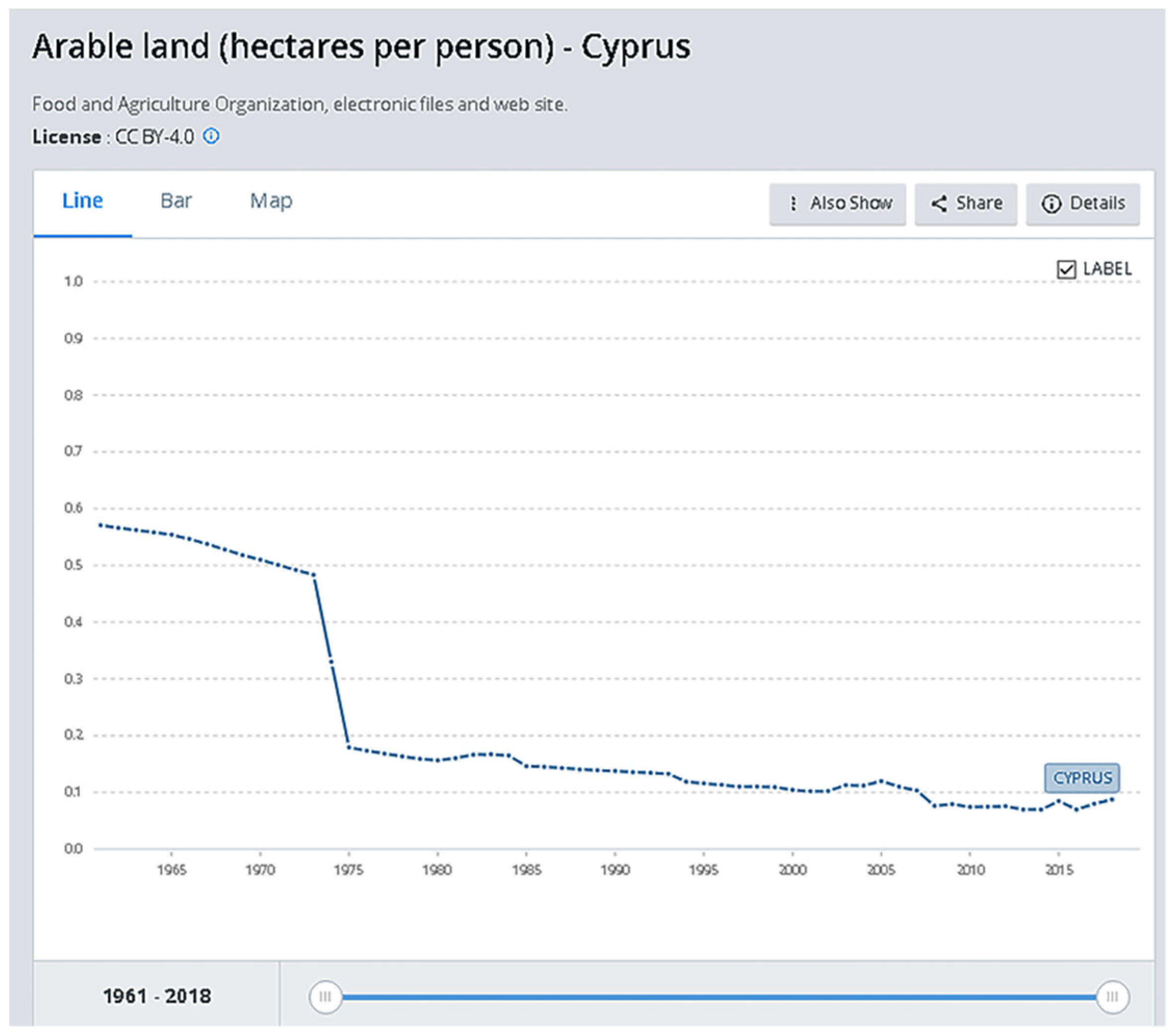




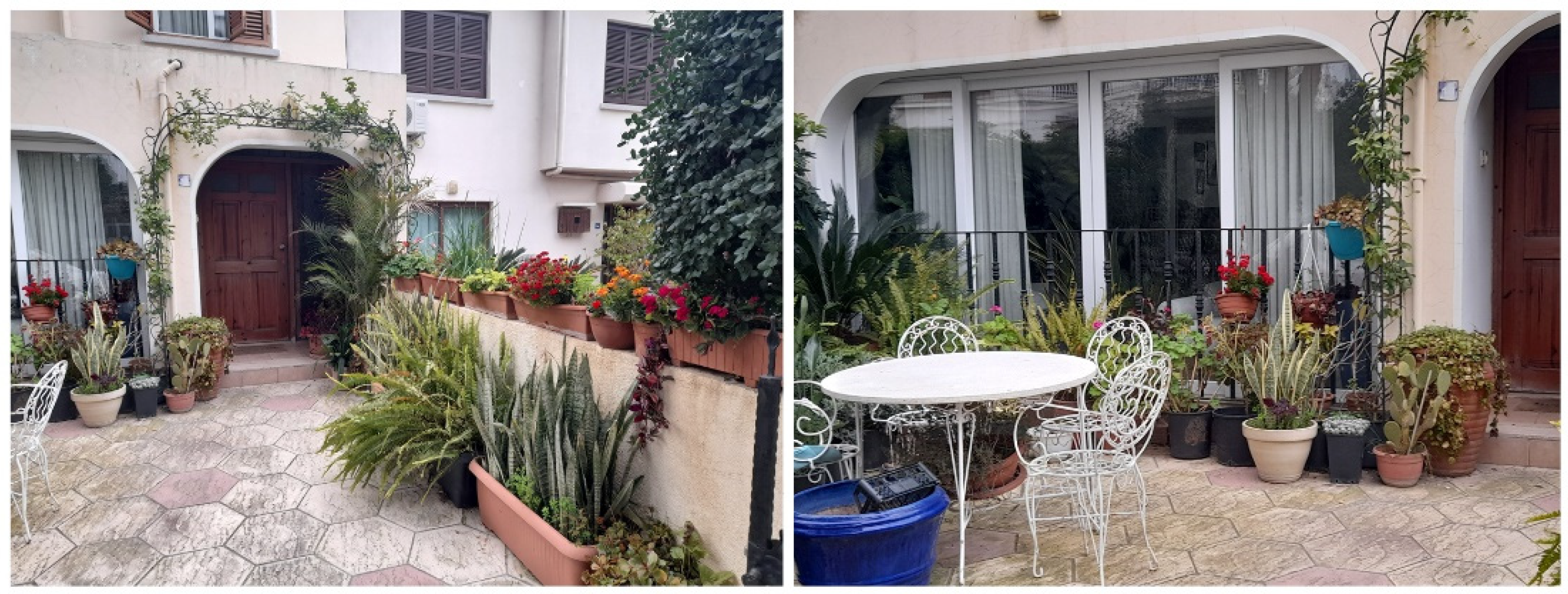


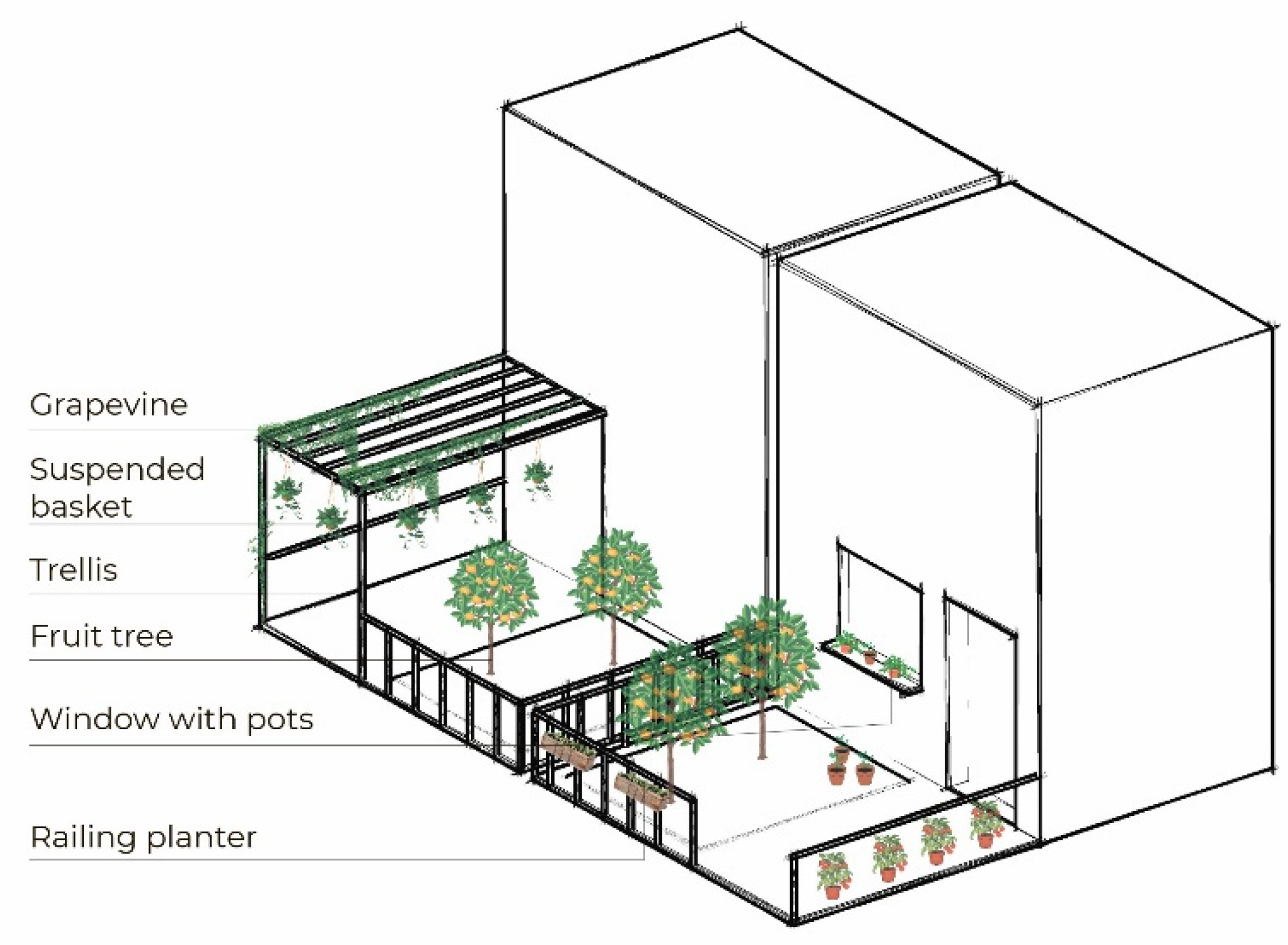
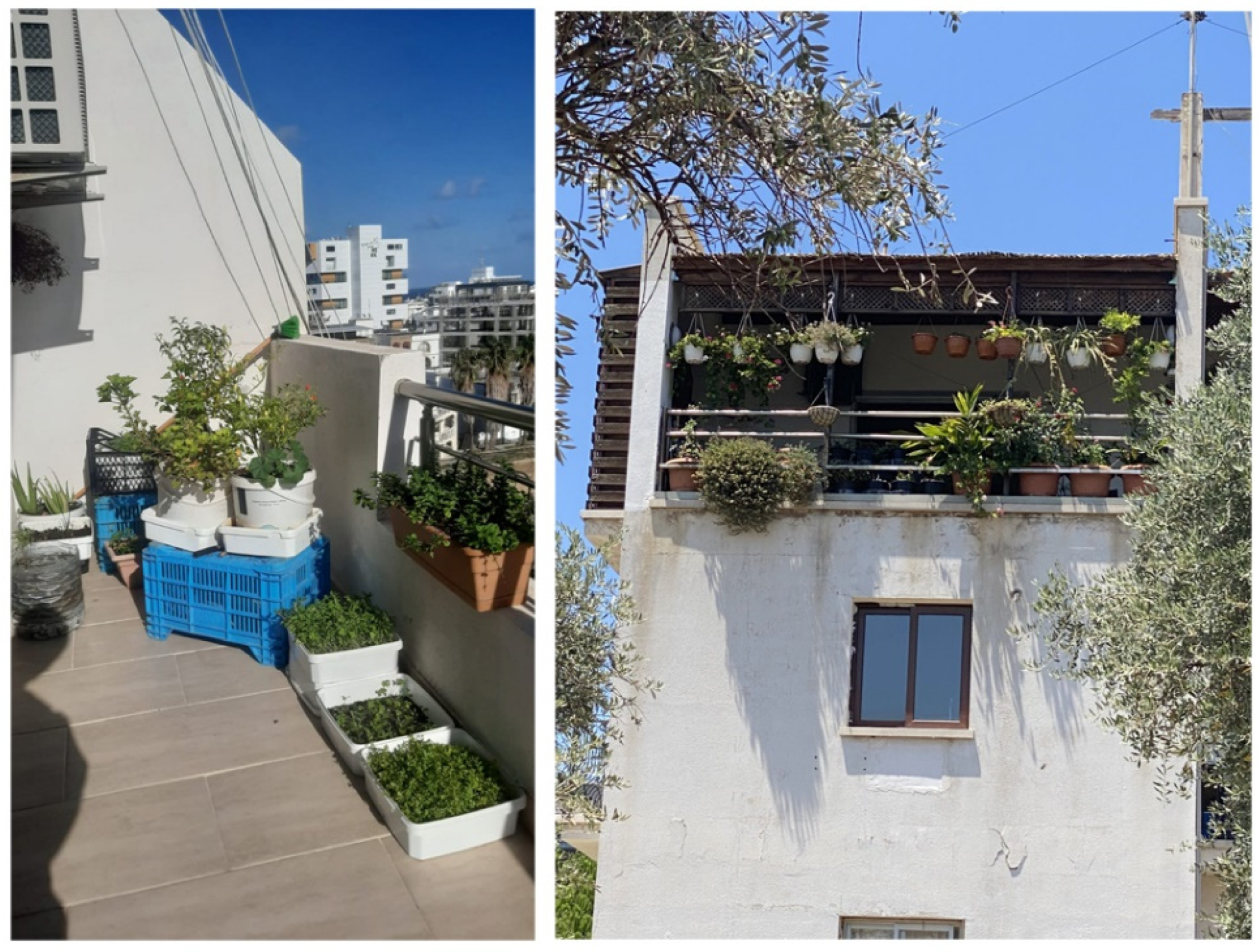

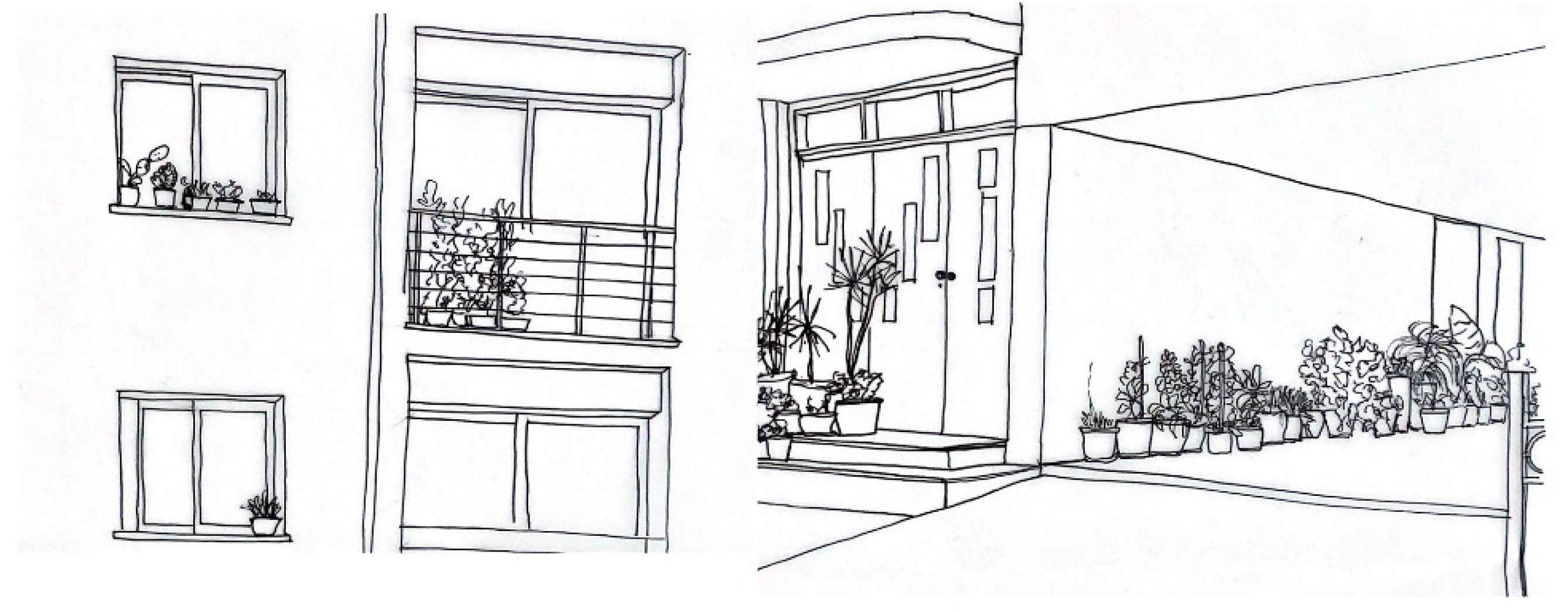
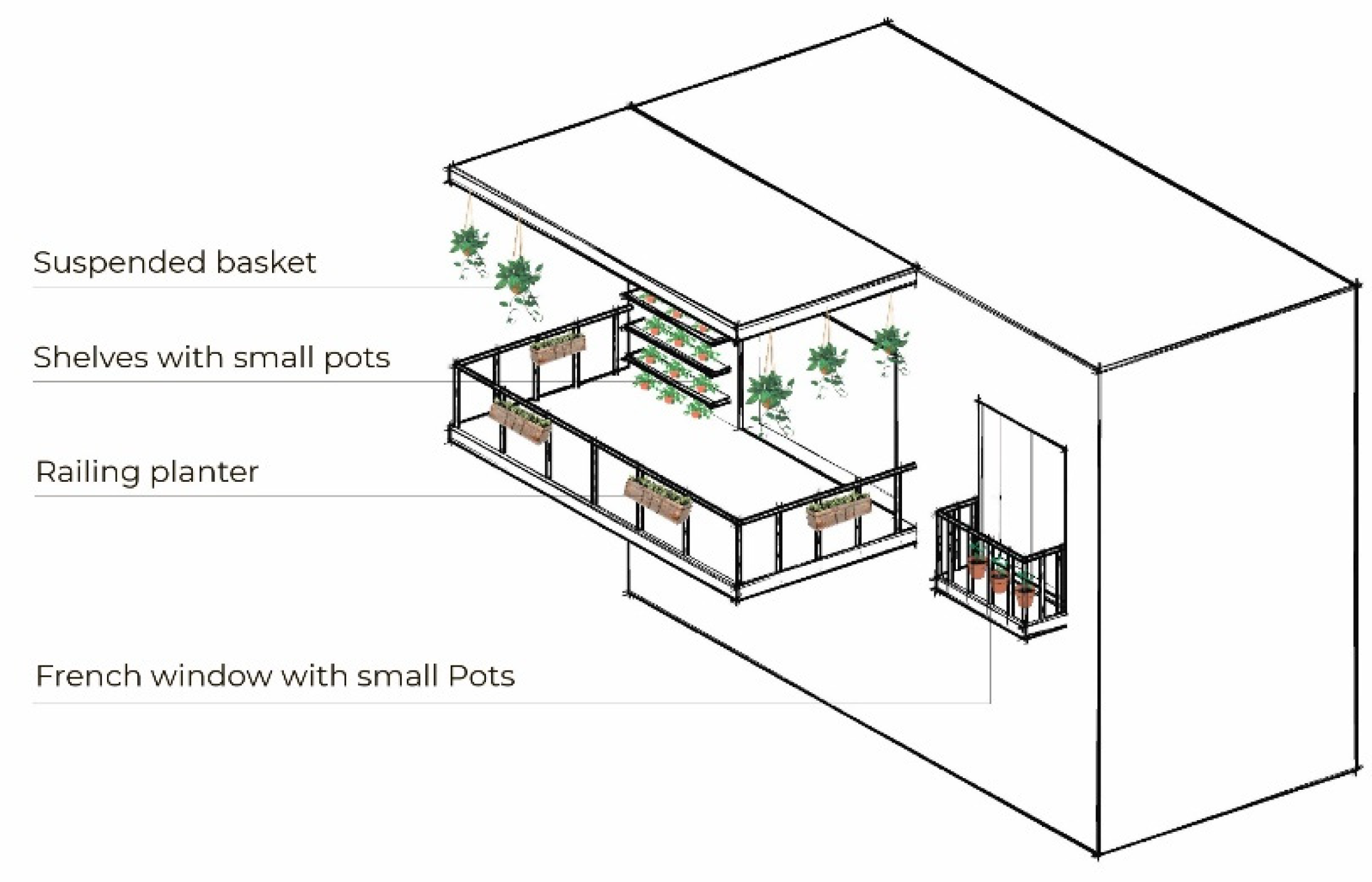

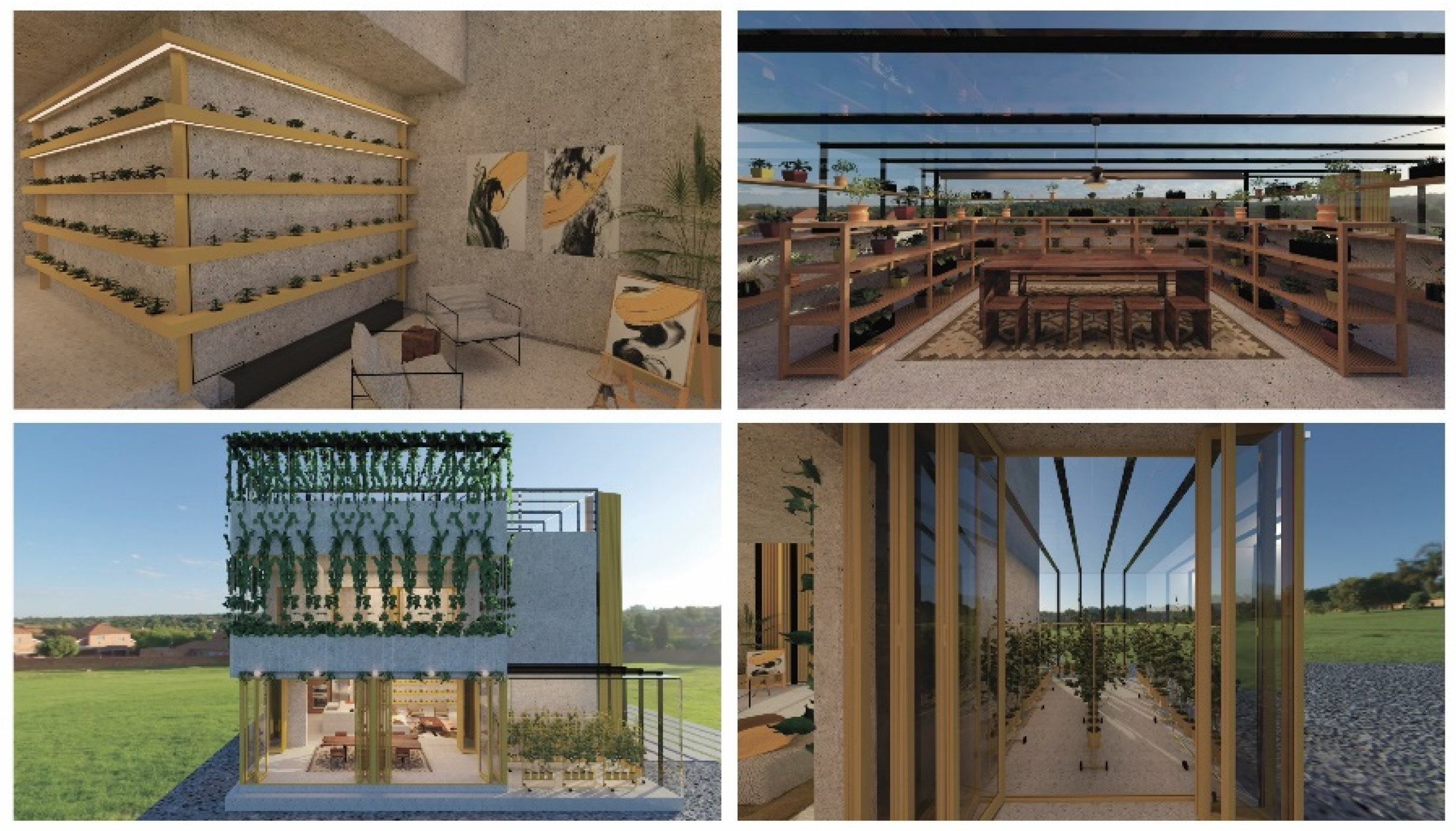
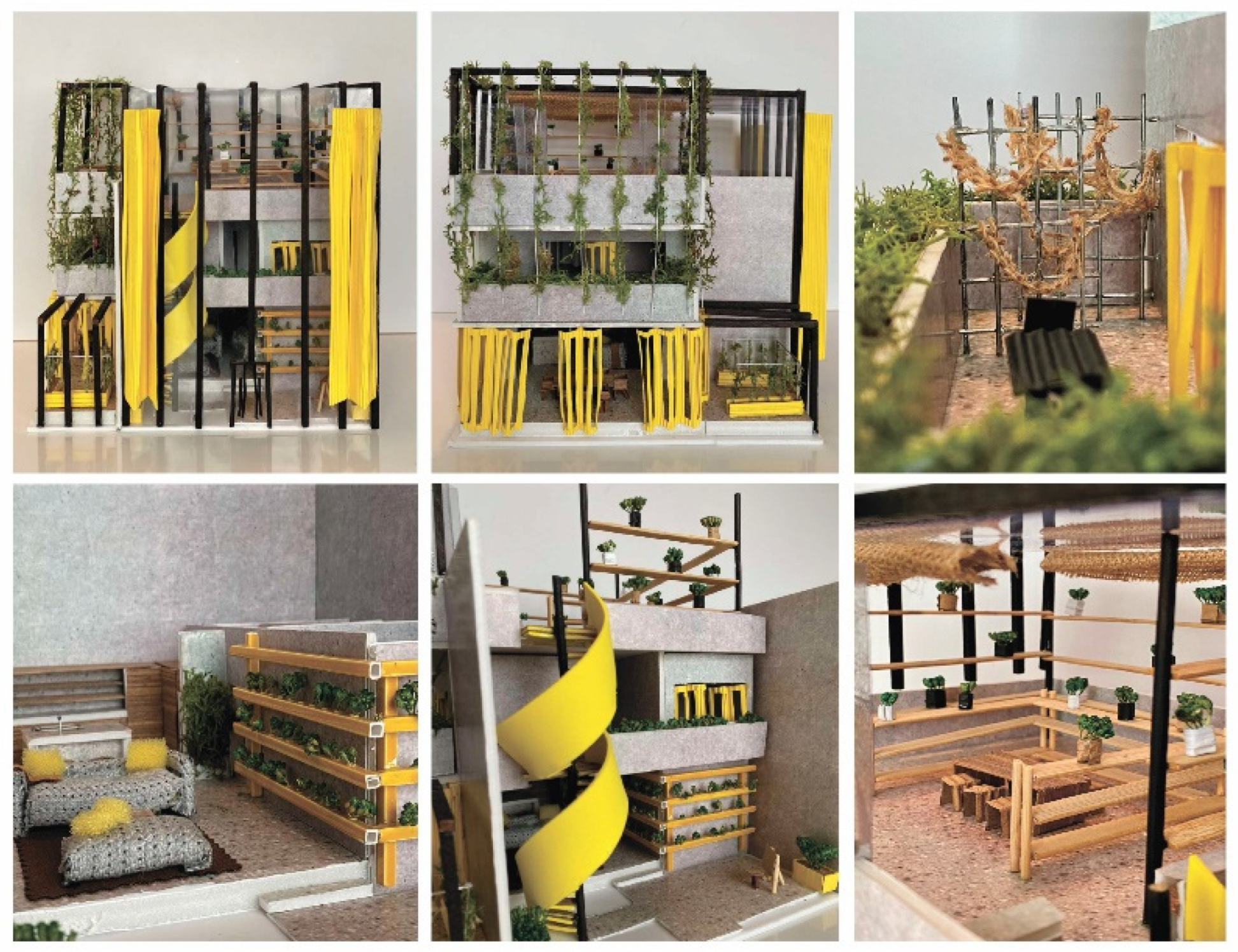
| Phase one: literature review |
|
| Phase two: data collection |
|
| Phase three: incorporating the bellow concepts within the interior design studio |
|
| Phase four: pedagogical framework definition and application within the interior design studio |
|
| Phase one: context analysis | 1. Visit the designated residential building and provide visual analysis. 2. Conduct fieldworks and visit Cypriot houses. Provide visual analysis of the ways green elements and edible gardens are arranged. 3. Converse with the locals and learn about local practices. |
| Phase two: research phase | 1. Deliver necessary theoretical background to young designers via weekly lectures. 2. Engage in research with young designers. 3. Select and identify successful case study interior design projects. Identify successful design propositions for each case study. Build an inventory of design propositions. |
| Phase three: design process | 1. Interpret the selected design propositions within the initial design proposal. 2. Integrate the innovative approaches for cultivating food within the initial design proposal. 3. Deliver the initial design proposal and receive feedback. 4. Deliver the final design project. |
| Residential urban agriculture |
|
| The context-based and culture-based design approach |
|
| Social sustainability |
|
Publisher’s Note: MDPI stays neutral with regard to jurisdictional claims in published maps and institutional affiliations. |
© 2022 by the authors. Licensee MDPI, Basel, Switzerland. This article is an open access article distributed under the terms and conditions of the Creative Commons Attribution (CC BY) license (https://creativecommons.org/licenses/by/4.0/).
Share and Cite
Pakravan, S.; Keynoush, S.; Daneshyar, E. Proposing a Pedagogical Framework for Integrating Urban Agriculture as a Tool to Achieve Social Sustainability within the Interior Design Studio. Sustainability 2022, 14, 7392. https://doi.org/10.3390/su14127392
Pakravan S, Keynoush S, Daneshyar E. Proposing a Pedagogical Framework for Integrating Urban Agriculture as a Tool to Achieve Social Sustainability within the Interior Design Studio. Sustainability. 2022; 14(12):7392. https://doi.org/10.3390/su14127392
Chicago/Turabian StylePakravan, Sarvenaz, Shahin Keynoush, and Ehsan Daneshyar. 2022. "Proposing a Pedagogical Framework for Integrating Urban Agriculture as a Tool to Achieve Social Sustainability within the Interior Design Studio" Sustainability 14, no. 12: 7392. https://doi.org/10.3390/su14127392
APA StylePakravan, S., Keynoush, S., & Daneshyar, E. (2022). Proposing a Pedagogical Framework for Integrating Urban Agriculture as a Tool to Achieve Social Sustainability within the Interior Design Studio. Sustainability, 14(12), 7392. https://doi.org/10.3390/su14127392







